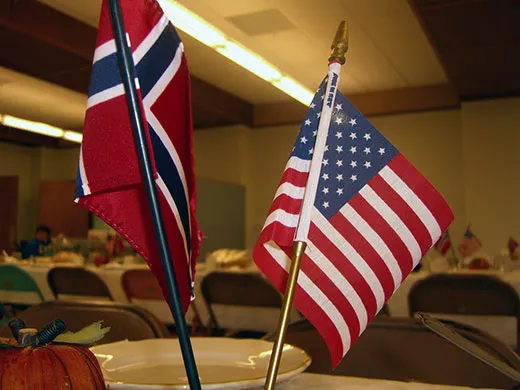Scandinavians’ Strange Holiday Lutefisk Tradition
People in the Old Country won’t touch the stuff, but immigrants to the American Midwest have celebrated it for generations
/https://tf-cmsv2-smithsonianmag-media.s3.amazonaws.com/filer/Lutefisk-dinner-631.jpg)
Although the doors don’t open until 11 a.m., the parking lot is already filling up on a Friday morning at Lakeview Lutheran Church in Madison, Wisconsin. Inside, volunteers busily set tables, stir boiling pots and dish out plates of food they’ve been planning and preparing for weeks. Outside, pink-cheeked diners decked in Nordic sweaters head up the steps, eager for their annual taste of lye-soaked cod drenched in melted butter.
“I like lutefisk! It tastes good to me,” says Nelson Walstead with a laugh. Walstead, a Norwegian-American, is the chief organizer of Lakeview Lutheran’s annual lutefisk dinner. “It makes me feel good to know we are keeping the tradition alive, and that we’re passing this on to the next generation,” he says.
It seems only natural that the descendants of the Vikings, perhaps history’s greatest tough guys, would celebrate a food prepared with a caustic and highly dangerous substance. Lutefisk—codfish (fisk) preserved in lye (lut)—is both a delicacy and a tradition among Scandinavian-Americans, who serve the chemical-soaked, gelatinous fish with a warm and friendly smile. Lutefisk, or lutfisk in Swedish, is a traditional dish in Norway, Sweden, and parts of Finland.
But today, Scandinavians rarely eat lutefisk. Far more lutefisk is consumed in the United States, much of it in church and lodge basements. In fact, the self-proclaimed “lutefisk capital of the world” isn’t in Norway but in Madison, Minnesota, where a fiberglass codfish named “Lou T. Fisk” welcomes visitors to this lye-fish loving town. The lutefisk dinner is an annual fall and winter tradition at scores of Lutheran churches and Nordic fraternal groups throughout the Upper Midwest and Pacific Northwest or anywhere with a large Scandinavian-American population. Strangely, these children of immigrants celebrate a tradition that connects them to their ancestral home, even as many Scandinavians have moved on.
“These dinners represent important traditions in both families and communities, and for some, they are a valued connection to culture and heritage,” says Carrie Roy, a Scandinavian cultural scholar and creator of the film Where the Sacred Meets the Quivering Profane: Exploring the Public and Private Spheres of Lutefisk “While the food tradition certainly originated in Scandinavia, the immigrant communities—especially their churches and cultural heritage lodges—have played a major role in developing the phenomenon of lutefisk dinners.”
Lutefisk starts as cod, traditionally caught in the cold waters off Norway. It’s then dried to the point that it attains the feel of leather and the firmness of corrugated cardboard. Water alone can’t reconstitute the fish, so it’s soaked in lye. Yes, lye, the industrial chemical used to unclog drains and dispose of murder victims, the one that explodes when it comes in contact with aluminum. Incidentally, it’s the same chemical that gives pretzels that deep, shiny brown, cures fresh olives for eating, and what makes bagels gleam; these foods just don’t advertise this fact like lutefisk does. The fish is then repeatedly rinsed before being shipped off for cooking and eating. But it’s still so close to toxic that the state of Wisconsin specifically exempts lutefisk from classification as a toxic substance in Section 101.58 (2)(j)(f) of its laws regulating workplace safety.
A strong fishy odor wafts through the stairwell at Lakeview Lutheran as diners dig into steaming platters of lutefisk served family style. Melted butter sits in ceramic pitchers for easy pouring, though other dinners feature a mustard or cream sauce. The fish itself is flaky and a slightly translucent white in color. While still firm in places, the fish tends to be slippery and a little squishy, and the whole platter quivers a bit as it makes its way down the table.
The rest of the meal is a fairly standard slate of starchy seasonal fare: mashed potatoes with gravy, creamy coleslaw, cranberries, green beans and a big bowl of mashed rutabagas that are nearly indistinguishable at quick glance from the mashed potatoes. A pile of rolled lefse, the Scandinavian potato flatbread similar in appearance to a flour tortilla, sits in the center of the table beside sticks of butter and bowls of brown sugar, lefse’s usual dressing.
Lutefisk is a polarizing dish, even among those at the dinners.
“I won’t touch the stuff. My wife was the Norwegian one,” says Ed, who has come to Lakeview’s dinner for a decade or more. “I like to come, though. And I really like the lefse!”
In the wrong hands, lutefisk can turn into slimy glop. For the haters, there’s always meatballs, a hand-rolled peace offering for mixed marriages of Scandinavians to spouses of different ethnic heritages, and for those with Scandinavian blood who object to lutefisk’s texture and intense odor.
The plaintive question frequently asked of lutefisk lovers: “If it’s so good, why don’t you eat it more than once a year?”
“Lutefisk is the substance you love to hate,” writes Roy. “It’s a rich substance for jokes, and for these reasons, it holds an interesting spectrum of appeal that varies from the cherished to reviled.”
That notorious smell has improved in recent years, however. Modern processing methods, including enclosed commercial kiln dryers and the refinement of lye, make for better smelling—or at least less smelly—fish. The lye does leave a distinct ashy taste that butter helps mask. Still, few people make lutefisk from scratch at home anymore, preferring instead to purchase it vacuum-packed from the store. Those searching for the smelly scent memory of old, however, can still find it at Ingrebretson’s Scandinavian Foods, a Minneapolis institution that hosts an annual lutefisk tasting, where shoppers can buy dried fish to soak themselves. There aren’t too many takers.
No one is quite sure where and when lutefisk originated. Both Swedes and Norwegians claim it was invented in their country. A common legend has it that Viking fishermen hung their cod to dry on tall birch racks. When some neighboring Vikings attacked, they burned the racks of fish, but a rainstorm blew in from the North Sea, dousing the fire. The remaining fish soaked in a puddle of rainwater and birch ash for months before some hungry Vikings discovered the cod, reconstituted it and had a feast. Another story tells of St. Patrick’s attempt to poison Viking raiders in Ireland with the lye-soaked fish. But rather than kill them, the Vikings relished the fish and declared it a delicacy. It makes for a great story if you don’t mind the fact that Patrick lived centuries before the Vikings attacked Ireland.
Whatever its origins, Scandinavians have eaten lutefisk for centuries. Preserved cod provided protein during the long winter months for generations of families in a part of the world with a strong tradition of fishing. Lye was used for making soap and preserving food. It was easily prepared in the kitchen by boiling wood ash from beech or birch in water and straining the result. Lutefisk first appeared in Norwegian literature in 1555 in the writings of Olaus Magnus, who describes its preparation and proper serving method: lots of butter.
Despite its long history in Scandinavia, though, lutefisk has fallen out of favor now that few people need to preserve food to last all winter. In fact, the Norwegian national dish isn’t lutefisk or even fishbased; it’s farikal, a lamb and cabbage casserole.
“You see some lutefisk in Norway but you’ll find many people who’ve never had it. There’s just not the lutefisk culture in Scandinavia that exists here,” says Eric Dregni, a Minnesotan who spent a year in Norway and wrote the book In Cod We Trust: Living the Norwegian Dream about his experiences. “It’s the immigrants that have kept this going and turned it into a community event.”
Andrine Wefring at the Culinary Academy of Norway in Oslo agrees. “People still eat it, usually at Christmas, and you can find it in some restaurants in the winter. But church dinners? No, that doesn’t happen here,” she says.
Poverty and the collapse of traditional farming practices led more than 950,000 Norwegians to leave their homes for America in the late 19th and early 20th centuries. Only Ireland experienced a greater exodus relative to the size of its population. Lutefisk, the food of poor Scandinavians, came to the United States with its immigrants. Today, there are nearly as many Americans with primarily Norwegian heritage as there are citizens of Norway, about 4.5 million people. And many of the immigrant descendants crave some connection to their Nordic past, even one that jiggles and seems to repel more than it appeals.
“It’s a symbol of solidarity,” says Hasia Diner, a professor of immigration history at New York University. “Foods like lutefisk could have been markers of poverty in the past, but by eating them in the more prosperous present, they serve to remind consumers where they came from and how far they have come.”
Professor Diner notes that it’s common for subsequent American-born generations to find these immigrant foods offensive. “Some individuals may find them disgusting, but they still offer markers of past authenticity,” she says.
So perhaps the nauseating aspects of lutefisk are also part of its appeal to Scandinavian-Americans: Eating dried cod cured in lye feels counterintuitive enough to forge a real connection to the practices of their ancestors.
Volunteers at Lakeview Lutheran cooked up 1,000 pounds of lutefisk for the November 4 dinner. They also rolled and grilled 235 dozen sheets of lefse, a labor-intensive process that began in the church kitchens in September. The lutefisk dinner, now in its 60th year, attracts nearly 1000 people to the table. Proceeds support the church’s outreach and mission work.
“It’s a ton of work to pull this off every year,” says Dean Kirst, pastor of Lakeview Lutheran. “But it helps us remember there was a time when our European ancestors struggled and suffered a lot even if we’re in more prosperous times now.”
It’s not all Scandinavians at the dinners. Pastor Kirst runs to the fridge to get a bottle of soy sauce for a Chinese-American woman who prefers her lutefisk with an Asian flair.
Even in the United States, the future of these dinners is uncertain. As the immigrant generation grows more remote from its roots, lutefisk consumption has declined. Those who love it tend to be those who grew up eating it, which is happening less and less. To tap younger eaters at home and abroad, in 2001 the Norwegian Fish Information Board launched a promotion to brand lutefisk as an aphrodisiac using a slogan that roughly translates as “Lutefisk lovers love more.” Olsen Foods in Minneapolis also markets a lutefisk TV dinner for the busy working family.
Pastor Kirst has seen a decline in attendance at his church’s lutefisk dinner. “People just don’t have the time they used to to devote to pulling off the dinner, and our membership is changing,” he says.
But among the traditional, lutefisk remains a cherished part of the holiday season. Many will travel from church to church throughout the fall and winter to get their fill of lutefisk, history and good Scandinavian cheer.
“It’s the combination of good food—we make good fish here—and tradition,” says Walstead. “I hope it never stops.”
Erika Janik is a writer and radio producer based in Madison, Wisconsin. She wrote for Smithsonian.com about salamanders that refuse to grow up.


